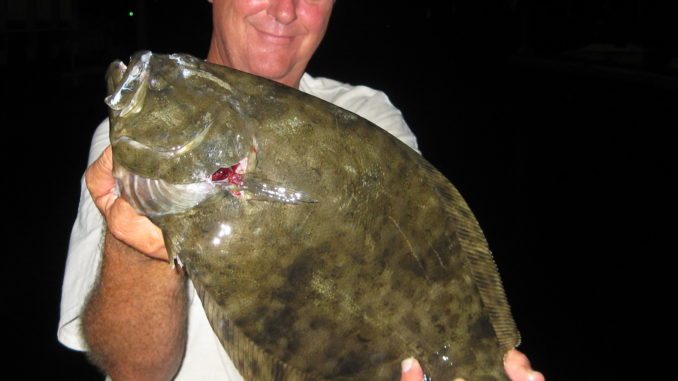
Calm, summer nights are perfect times to target flounder and other inshore species with a light, a gig and an appetite.
It gets mighty hot on the Carolinas’ coast in July. Fishing during the day can be a sweltering experience, especially if there is little or no wind blowing. An alternative is to go flounder-gigging at night to beat the heat.
That’s where Daryl Graham of Charleston, S.C., comes into play. Graham runs Fish Sticker Charters, does almost all of his work after dark, and fills coolers not with a rod and reel but a gig.
“If you don’t mind going out after dark and staying out most of the night, flounder-gigging is a very productive way to put fresh fish in the box,” said Graham (843-270-6667). “Sometimes, we get black drum, sheepshead, sea trout and tripletail.”
Gigging is an inexpensive way of taking fish, but there are several things to consider before going: boat, equipment, moon, tides and weather.
Any shallow-draft boat will work because most of the water will be no more than 4 feet deep. Generally, a 14- to 16-foot, flat-bottom boat is preferred as long as it can maneuver around in less than a foot of water and is stable and wide enough for giggers at the bow and stern to stand comfortably for several hours.
Except for the boat and motor, very little equipment is needed, but the boat has to be equipped with a light, batteries or generator, gigging poles and a cooler to hold the fish.
Back in the “old days,” giggers would hang a Coleman lantern over the side of the boat, with its back half covered with foil. Graham uses a halogen light mounted in a rod holder on the gunwale not far from the bow. He prefers a small Honda generator over batteries to supply power all-night long.
Graham carries least four gigging poles at all times. They come in a variety of types and lengths, but he prefers a 14-foot, wooden pole. He likes wooden poles because they grip better than metal, and he also uses them to push or pole the boat.
Graham uses a five-prong gig and likes metal gigs over stainless. Depending on how many gigging trips he takes, the gig heads get dull. He can easily sharpen the prongs with a grinder, but they last only one season.
Graham favors gigging on a dark moon with no or light wind.
“The least amount of light is better,” he said. “The more light, the more skittish the fish are. Also, you have to have no or light wind to spot the fish.
“Clean water with a falling or low tide is the best time to gig,” You are just easing along and poling with the light mounted on the side, and waiting for baitfish to come out of the grass and looking for fish to gig.
“The trick in flounder-gigging is learning to spot the fish,” he said. “What you are looking for is the outline of the fish.”
You are not really looking into the lighted water, but just outside the light in the shadows. Once you recognize the first fish, they become much easier to spot.
“Once the flounder is spotted, put the gig as close as you can behind the head and strike hard,” Graham said. “Hit them behind the head with all five prongs and pin the fish to the bottom.
“On a hard bottom, you have to hit them especially hard. You know you got them when they stop kicking.”
Graham generally starts gigging in late April and gigs through mid-October; the best action is always on hot, summer nights.
So if staying up half the night does not bother you, gigging for flounder is a totally different type of sight-fishing. Everything seems different at night, especially stalking the fish. The best part is that the sun is not bearing down on you, and you beat the heat.



Be the first to comment